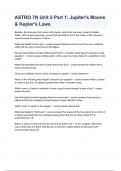Jupiter Study guides, Class notes & Summaries
Looking for the best study guides, study notes and summaries about Jupiter? On this page you'll find 684 study documents about Jupiter.
Page 3 out of 684 results
Sort by
ASTRO 7N Unit 2 Part 1 Jupiters Moons & Keplers Laws with complete solution / Latest updated .
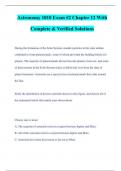
-
Astronomy 1010 Exam #2 Chapter 12 With Complete & Verified Solutions
- Exam (elaborations) • 12 pages • 2023
-
Available in package deal
-
- $9.49
- + learn more
Astronomy 1010 Exam #2 Chapter 12 With Complete & Verified Solutions During the formation of the Solar System, smaller particles in the solar nebula combined to form planetesimals, some of which provided the building blocks for planets. The majority of planetesimals did not become planets, however, and some of them remain in the Solar System today as debris left over from the time of planet formation. Asteroids are a special class of planetesimals that orbit around the Sun. Study the distribut...
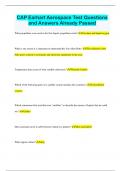
-
CAP Earhart Aerospace Test Questions and Answers Already Passed
- Exam (elaborations) • 22 pages • 2024
- Available in package deal
-
- $9.99
- + learn more
CAP Earhart Aerospace Test Questions and Answers Already Passed What propellants were used in the first liquid- propellant rocket? Gasoline and liquid oxygen What is one reason it is important to understand the Van Allen Belts? The radiation in the belts poses a threat to astronauts and electronic equipment in the area. Temperature data is part of what satellite subsystem? Thermal Control Which of the following parts of a satellite system includes the customers? Constellation sy...

-
Civil Air Patrol CAP Mitchell Award Aerospace Terms 100% Correct
- Exam (elaborations) • 15 pages • 2024
-
- $10.49
- + learn more
satellite natural or artificial object in space that orbits the Earth orbit the path a satellite takes around a celestial body apogee the highest point of an orbit perigee the lowest point of an orbit Sputnik the first artificial satellite COMSTAT communications satellites INTELSAT International Telecommunications Satellite Organization NAVSTAR navigation satellitesLANDSAT satellites that locate natural resources and monitor conditions on the Earth's surface GOES Geostationary Operatio...
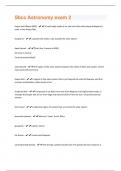
-
Sbcc Astronomy exam 2 Questions With 100% Correct Answers
- Exam (elaborations) • 10 pages • 2024
- Available in package deal
-
- $7.99
- + learn more
Kuiper belt Object (KBO) - A small body made of ice and rock that orbits beyond Neptune's orbit, in the Kuiper Belt. Exoplanet - a planet that orbits a star outside the solar system dwarf planet - Pluto (has 5 moons in KBO) Eris (has 5 moons) Ceres (in asteroid belt) asteroid belt - the region of the solar system between the orbits of Mars and Jupiter, where many asteroids are found Kuiper belt - A region of the solar system that is just beyond the orbit of Neptune and that contains sm...

-
Civil Air Patrol CAP Mitchell Award Aerospace Terms 100% Correct
- Exam (elaborations) • 15 pages • 2024
-
- $10.49
- + learn more
satellite natural or artificial object in space that orbits the Earth orbit the path a satellite takes around a celestial body apogee the highest point of an orbit perigee the lowest point of an orbit Sputnik the first artificial satellite COMSTAT communications satellites INTELSAT International Telecommunications Satellite Organization NAVSTAR navigation satellitesLANDSAT satellites that locate natural resources and monitor conditions on the Earth's surface GOES Geostationary Operatio...
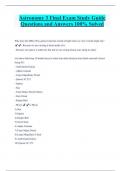
-
Astronomy 3 Final Exam Study Guide Questions and Answers 100% Solved
- Exam (elaborations) • 34 pages • 2024
- Available in package deal
-
- $14.99
- + learn more
Astronomy 3 Final Exam Study Guide Questions and Answers 100% Solved Why does the Milky Way galaxy look like a band of light when we view it in the night sky? ️️- Because we are viewing it from inside of it. - Because our galaxy is relatively flat and we are seeing distant stars along its plane. List these following 10 bodies/areas in order from their distance from Earth outward (closest being #1): - Andromeda Galaxy - Alpha Centauri - Large Magellanic Cloud - Quasar 3C 273 - Ju...
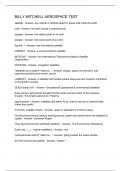
-
Billy Mitchell Aerospace Test
- Other • 16 pages • 2023
-
- $7.99
- + learn more
satellite - Answer- any natural or artificial object in space that orbits the earth orbit - Answer- the path around a celestial body apogee - Answer- the highest point in an orbit perigee - Answer- the lowest point of an orbit Sputnik 1 - Answer- the first artificial satellite COMSAT - Answer- a communications satellite INTELSAT - Answer- the International Telecommunications Satellite Organization NAVSTAR - Answer- navigation satellites "Satellites as a system" refers ...
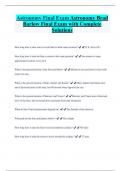
-
Astronomy Final Exam Astronomy Brad Barlow Final Exam with Complete Solutions
- Exam (elaborations) • 16 pages • 2024
- Available in package deal
-
- $12.99
- + learn more
Astronomy Final Exam Astronomy Brad Barlow Final Exam with Complete Solutions How long does it take stars to circle back to their same location? ️️23 h, 56 m, 04 s How long does it take the Sun to return to the same position? ️️Sun returns to same approximate location every 24 h What is the general motion of the Sun and Moon? ️️Motion of sun and moon is East with respect to stars What is the general motion of Mars, Jupiter and Saturn? ️️Mars, Jupiter and Saturn also ...
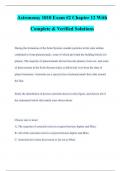
-
Astronomy 1010 Exam #2 Chapter 12 With Complete & Verified Solutions
- Exam (elaborations) • 12 pages • 2023
-
- $11.48
- + learn more
During the formation of the Solar System, smaller particles in the solar nebula combined to form planetesimals, some of which provided the building blocks for planets. The majority of planetesimals did not become planets, however, and some of them remain in the Solar System today as debris left over from the time of planet formation. Asteroids are a special class of planetesimals that orbit around the Sun. Study the distribution of known asteroids shown in this figure, and choose all of t...

How did he do that? By selling his study resources on Stuvia. Try it yourself! Discover all about earning on Stuvia

